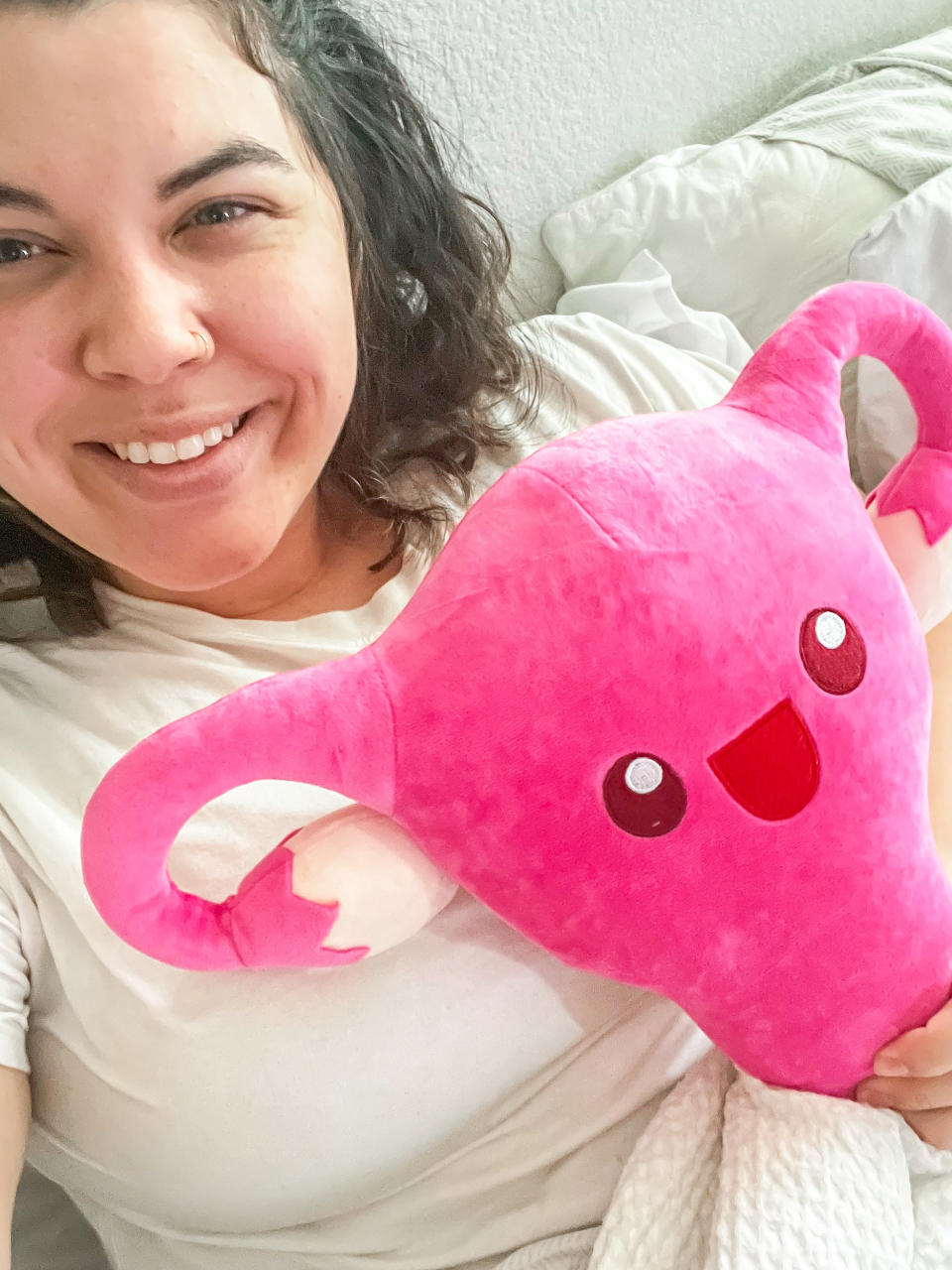Mom, 25, fought 12 years to get right diagnosis for her debilitating pain
At 13, Halley Thaxton was rehearsing to take part in the Macy’s Thanksgiving Day Parade when the cramps began.
“I was throwing up — the pain was just unbearable,” the now 25-year-old from Arizona tells TODAY.com. “I was curled up in a ball in the bathroom.”

She went home, “hoping, praying” that she could return to rehearsals and participate in the parade. She later visited a doctor to understand why she experienced such overwhelming pain.
“They found an ovarian cyst that was really small. So obviously that wasn’t the cause of the pain. It was too small,” she says. “That was when they first started talking about probable endometriosis.”
Over the years, she’s tried different birth controls to try to treat her symptoms with varying success. Her painful, heavy periods continued, and she was diagnosed with adenomyosis, a condition where the endometrial tissue grows into the uterus' muscles, causing pain and heavy bleeding.
“I just cried when I saw that it confirmed adenomyosis,” she says. “It wasn’t in my head.”
History of heavy bleeding, pain, miscarriages
Thaxton’s doctors first suspected endometriosis — a condition where tissue like the lining of the uterus grows outside the uterus — when she came to them with extremely painful, heavy periods.
“(This) was interesting because you usually don’t hear that at 14. Usually, it takes a lot longer to hear that word mentioned,” she says.
Thaxton began taking birth control with “the highest does of estrogen they could possible give,” she recalls. But she experienced side effects from the birth control and eventually stopped taking it.
“I never had a good treatment plan,” she says. “I really just lived in pain, trying my best to just manage with ibuprofen, Midol, a heating pad, whatever I could use to get relief.”
The pain worsened as she aged. In college, she missed a final exam when pain sent her to the hospital via an ambulance mid-test.
“I was able to re-take my final," Thaxton says. "But it was traumatic.”
Sometimes, she wondered if she'd had an ovarian cyst rupture and that caused the pain and bleeding she felt.
“The level of pain that I was experiencing and ... they find nothing. So, I really lived for years convinced it was all in my head,” she says. “Nobody ever really took the time to educate me.”
She'd bleed through a tampon and pad in an hour, which interfered in her daily life.
“Emotionally, it was draining,” she says. “I missed out on a lot because of the pain. And it was just unbearable and the embarrassment of having to go the bathroom every hour, every period to go change your tampon.”

Thaxton got married and tried having children. She experienced a miscarriage before becoming pregnant with her first daughter. About five months after giving birth, her symptoms intensified.
“We brushed it off. It was like PMS or whatever, I dealt with my whole life,” she says. “It got so bad we actually did end up going back into the ER.”
Doctors thought she had appendicitis and removed her appendix. During surgery, they noticed something unusual about her uterus.
“(They said), ‘Nothing is wrong with your appendix, but your uterus was enlarged, so follow-up with your gynecologist,’” Thaxton recalls.
She visited her OB-GYN, who dismissed her symptoms as postpartum changes.
“He didn’t even do a pelvic exam. He just said, ‘Well you just had a baby so that’s probably it.’ I left,” Thaxton says. “I was furious.”
She went to a different gynecologist, who performed a pelvic exam and an ultrasound but ultimately didn’t see anything.
“Again, it was just brushed off as endometriosis,” she says. “I was given the option of basically birth control again.”
The doctor also gave her the option of another medication that she'd heard had bad side effects or surgery that would prevent her from getting pregnant again. While she didn’t want to have a child immediately, she knew she’d like to try again.
“I didn’t really have any good options and still had not heard at this point about adenomyosis,” she says.
What is adenomyosis?
Adenomyosis is a condition is similar to endometriosis, but the tissue only grows in the uterus. Endometriosis can be found throughout the body, including in the lungs, brain and membrane enclosing the heart.
“It’s often termed as a sister disease of endometriosis, (but) it’s not the same disease,” Dr. Karli Goldstein, an endometriosis specialist at the Seckin Endometriosis Center and member of the Endometriosis Foundation of America, tells TODAY.com. “Basically, adenomyosis can occur in the outside of the uterus. It could occur in the walls of the uterus, and it can even occur in the endometrial lining.”
It “most often” grows in the walls of the uterus, she explains.
“The endometrial cells, the glands and stoma, that actually live in the endometrium actually are growing out of place in the walls of the uterus instead,” Goldstein says.
When the tissue grows into the walls of the uterus, it causes symptoms that include:
Pain
Heavy bleeding during menstruation
Bleeding after sex
Irregular bleeding between periods
“Traditionally, patients who have very, very heavy bleeding and have really significant pain, adenomyosis is pretty high on the list,” Dr. Michael Nimaroff, chair of obstetrics and gynecology and minimally invasive gynecologic surgery at Long Island Jewish Medical Center, tells TODAY.com.
The "definitive" treatment is usually a hysterectomy, he adds.
Some patients with adenomyosis might also experience fertility problems.
“We’ve been finding that patients who have pregnancy loss … and other preterm labor issues, some of these are associated with adenomyosis,” Nimaroff says. “It really obviously depends on how much distortion is created in the uterus.”
Ultrasound and MRI can sometimes detect adenomyosis without surgery. However, it’s most often diagnosed after the uterus is examined following surgical removal. It was once considered a condition that impacted older people who had given birth or had surgeries on the uterus. But doctors now think it occurs in more people.
“It was thought for a long time to be a disease that affected women that had multiple children in their 40s,” Goldstein says. “We’re actually seeing earlier cases of adenomyosis without having children. We’re seeing it even in teens and 20s and 30s in women or patients that have really painful cycles."

Nimaroff says it often occurs in people with endometriosis.
“Adenomyosis is found with endometriosis, and endometriosis is found with adenomyosis,” he says. “It’s a very common finding both ways.”
It’s unclear how common adenomyosis is because it’s likely under-diagnosed. Not everyone who experiences heavy bleeding and pain undergoes a hysterectomy, for example.
“There are studies that show that adenomyosis is found between 10% and 20% (of hysterectomies),” Nimaroff says. “Adenomyosis is much more common ... than we think.”
Some patients might not realize that heavy bleeding and intense pain are signs that something is wrong.
“It does cause very, very intense cramping, but because it may not cause all the surrounding symptoms, like endometriosis does, adenomyosis may be easier to dismiss" as just having really bad period, Goldstein says.
While a hysterectomy treats adenomyosis, not everyone wants one. Birth control can manage heavy bleeding, especially progesterone treatments. Other treatments called GnRH antagonists or GnRH agonists can "suppress the hormones" that contribute to the intense pain, Goldstein says.
Like Thaxton, many people notice their symptoms become more severe over time.
“It may have started with painful periods in their teens,” Goldstein says. "Then gradually, they’re getting worse and worse."
Finding an effective treatment
When trying to get pregnant a second time, Thaxton experienced two miscarriages. Her doctor ordered an endometrial biopsy, which came back with normal results.
“I hadn’t even heard the word adenomyosis,” Thaxton says.
She became pregnant again and carried the baby to term. While some doctors had suggested being pregnant might improve her symptoms, that was not the case.
“My symptoms came back so much worse,” she says. “I said, ‘This pain. I am done having kids. I would just like to have a hysterectomy.’”
Her doctor agreed and said they would excise any endometriosis they found. They performed an ultrasound prior to the surgery and Thaxton finally learned what caused so much pain and bleeding.
“They found the first signs that anybody had ever seen of the adenomyosis, and that’s where we saw that the lining was migrating into the muscle walls of the uterus,” she says. “I cried so much because it was the first time in 12 years that anybody had found something and could confirm to me that, 'No, this wasn’t in your head. You don’t just have a low pain tolerance.'”
During surgery in early March, doctors removed a few endometriosis lesions with excision, and pathology later confirmed her diagnosis of adenomyosis.
“Nobody noticed it. Nobody talks about it,” Thaxton says. “To finally have that peace that I was right … it’s very satisfying.”
She shared her joy of her upcoming hysterectomy in a Facebook post. She hopes that her experience encourages others to advocate for their health.
On average, it takes 10 years for a woman to be diagnosed with endometriosis. Adenomyosis can go undiagnosed or...
Posted by Halley Thaxton on Monday, February 13, 2023
“I hope that they learn they do need to fight, that they keep fighting and that it’s not in their head,” she says. “Nobody should feel like they don’t have a voice in their own care.”
This article was originally published on TODAY.com

